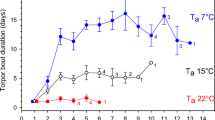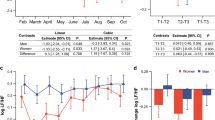Abstract
REPTILES reportedly possess physiological mechanisms for the increase or decrease in the rate of heat exchange with their environments. This the animal could do by changing either its metabolic rate or its effective insulation. Both sorts of mechanisms have been postulated responsible for this capability.
This is a preview of subscription content, access via your institution
Access options
Subscribe to this journal
Receive 51 print issues and online access
$199.00 per year
only $3.90 per issue
Buy this article
- Purchase on Springer Link
- Instant access to full article PDF
Prices may be subject to local taxes which are calculated during checkout
Similar content being viewed by others
References
Bartholomew, G. A., and Lasiewski, R. C., Comp. Biochem. Physiol., 16, 573 (1965); Bartholomew, G. A., and Tucker, V. A., Physiol. Zool., 36, 199 (1963); Bartholomew, G. A., Tucker, V. A., and Lee, A. K., Copeia, 1965, 169 (1965).
Weathers, W. W., Baker, L. A., and White, F. N., Physiologist Wash., 13, 336 (1970).
Weathers, W. W., and White, F. N., Amer. J. Physiol., 221, 706 (1971).
Morgareidge, K. R., and White, F. N., Nature, 223, 587 (1969).
Spray, D. C., and Belkin, D. B., Comp. Biochem. Physiol. (in the press).
Author information
Authors and Affiliations
Rights and permissions
About this article
Cite this article
SPRAY, D., BELKIN, D. Heart Rate-Cloacal Temperature Hysteresis in Iguana is a Result of Thermal Lag. Nature 239, 337–338 (1972). https://doi.org/10.1038/239337a0
Received:
Revised:
Issue Date:
DOI: https://doi.org/10.1038/239337a0
This article is cited by
-
Magnitude and ecological implications of thermal inertia in skipjack tuna,Katsuwonus pelamis (Linnaeus)
Environmental Biology of Fishes (1976)
-
Comportement thermoregulateur chezRana esculenta
Pfl�gers Archiv European Journal of Physiology (1973)
Comments
By submitting a comment you agree to abide by our Terms and Community Guidelines. If you find something abusive or that does not comply with our terms or guidelines please flag it as inappropriate.



